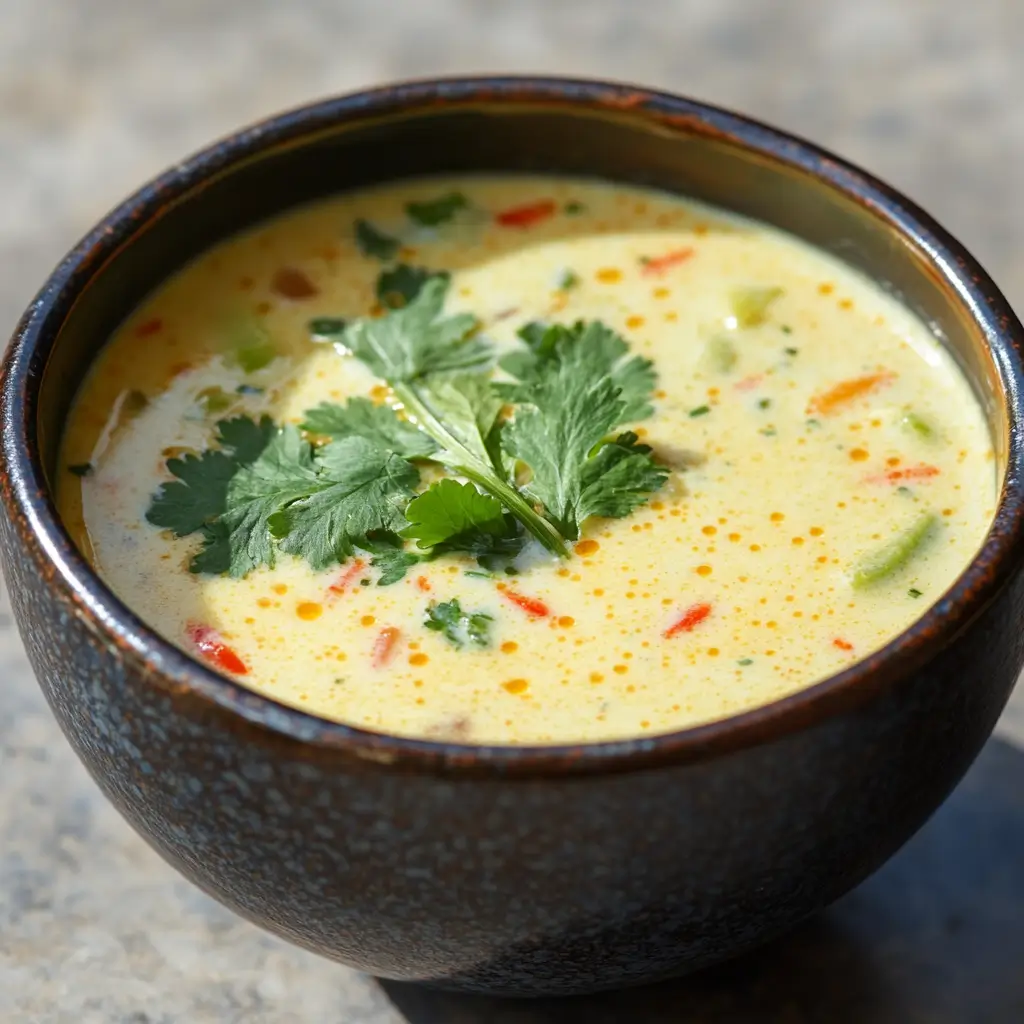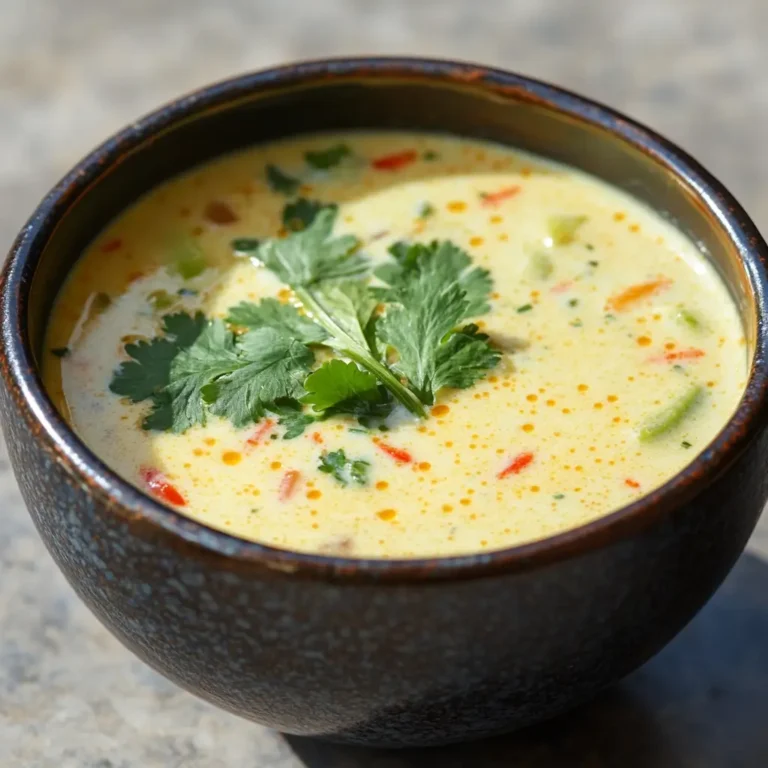Table of Contents
1. Introduction
As the late May evenings in Marrakesh offer a gentle warmth, there’s still a delightful comfort in a fragrant and flavorful soup. Today, we’re transporting your taste buds to Southeast Asia with our recipe for The Best Thai Coconut Soup. Often known as Tom Kha, this soup is a harmonious blend of creamy coconut milk, aromatic ginger and garlic, a hint of spice from chili, and the bright, zesty notes of lime. We’ve added tender shrimp (though you can easily substitute chicken, tofu, or more vegetables), earthy mushrooms, and crisp bean sprouts for a truly satisfying and exotic culinary experience.
This Thai Coconut Soup is surprisingly easy to make and comes together relatively quickly, making it perfect for a flavorful weeknight meal or an impressive starter for a dinner party. The balance of creamy, spicy, sour, and savory flavors is what makes Thai cuisine so captivating, and this soup beautifully exemplifies that. If you enjoy the vibrant tastes of Southeast Asia, much like in our Easy Spicy Shrimp Coconut Soup, you’ll find this Thai Coconut Soup absolutely irresistible. Let’s embark on this aromatic culinary journey!
2. Recipe Summary
- Cuisine: Thai
- Difficulty level: Easy
- Total preparation and cooking time: 50 minutes
- Dietary classification: Can be adapted to vegetarian/vegan.
3. Equipment and Utensils
- Large pot or Dutch oven
- Sharp kitchen knife
- Cutting board
- Measuring cups and spoons
- Stirring spoon
4. Serving Suggestions
- Plating: Serve hot in bowls, garnished generously with fresh chopped cilantro. A wedge of lime on the side allows for extra zest.
- Side Dish Ideas: Steamed jasmine rice is a classic accompaniment. You could also serve it with spring rolls or a light Asian salad.
- Complementary Side Dishes: Consider a side of stir-fried vegetables or our 20-min Creamy Peanut Tofu Ramen (Vegan) for a more substantial meal.
- Wine or Beverage Pairings: A crisp Gewürztraminer or a dry Riesling would pair well with the aromatic and slightly spicy flavors. For non-alcoholic options, try a refreshing Thai iced tea or coconut water.
5. Nutritional Information
- Detailed Nutritional Breakdown (per serving, estimated):
- Calories: N/A (will vary based on protein choice and quantities)
- Carbohydrates: Approximately 15-20g
- Protein: Approximately 15-25g (depending on shrimp/protein amount)
- Fat: Approximately 25-35g (primarily from coconut milk)
- Macronutrient Distribution: Varies.
- Dietary Information: Can be adapted to dairy-free, gluten-free (check curry paste and soy sauce if used).
- Potential Health Benefits: Coconut milk contains healthy fats. Ginger and chili have anti-inflammatory properties.
6. Storage and Reheating
- Proper Storage Instructions: Allow the soup to cool completely before transferring it to an airtight container. Store in the refrigerator for up to 2-3 days.
- Refrigeration Instructions: Keep refrigerated at or below 40°F (4°C).
- Freezing Recommendations: Freezing this soup is not ideal due to the coconut milk, which can sometimes separate upon thawing, affecting the texture. The shrimp’s texture might also change. It’s best enjoyed fresh.
- Reheating Methods:
- Stovetop: Gently reheat the soup in a pot over medium-low heat, stirring occasionally, until heated through. Avoid boiling to prevent the coconut milk from separating.
- Microwave: Reheat individual portions in a microwave-safe bowl, stirring every 1-2 minutes until hot.
7. Expert Tips and Variations
- Tips from Professional Chefs: Use full-fat coconut milk for the richest flavor and creamiest texture. Taste and adjust the lime juice, fish sauce, and chili to your preference.
- Common Mistakes to Avoid: Boiling the soup vigorously after adding the coconut milk; overcooking the shrimp, which can make it rubbery.
- Creative Recipe Variations:
- Protein: Substitute shrimp with chicken (sliced), tofu (cubed), or a mix of vegetables.
- Vegetables: Add bamboo shoots, baby corn, snow peas, or bok choy.
- Aromatics: Add lemongrass (bruised) or galangal for a more authentic flavor (remember to remove them before serving). Kaffir lime leaves (torn) can also be added during simmering.
- Spice Level: Adjust the amount of red chili or add a Thai chili paste like Sriracha for more heat.
- Vegetarian/Vegan: Omit the fish sauce (or substitute with soy sauce or tamari for gluten-free) and use vegetable broth. For protein, use tofu or extra vegetables.
- Seasonal Adaptations: This soup is enjoyable year-round. You might consider adding seasonal vegetables like fresh corn in the summer.
8. Ingredients Section
- 1 tablespoon coconut oil
- Quality and Sourcing Recommendations: Virgin coconut oil adds a nice aroma.
- 1 medium onion, chopped
- Sourcing: Yellow or white onion.
- Preparation Notes: Finely chop.
- 2 garlic cloves, minced
- Sourcing: Fresh garlic.
- Preparation Notes: Finely mince.
- 1 piece fresh ginger (about 2 cm), minced
- Sourcing: Fresh ginger root.
- Preparation Notes: Peel and finely mince.
- 1 red chili, finely chopped (or less to taste)
- Sourcing: Fresh red chili.
- Preparation Notes: Remove seeds for less heat.
- 400 ml coconut milk (full-fat recommended)
- Sourcing: Canned coconut milk.
- 400 ml chicken or vegetable broth
- Quality and Sourcing Recommendations: Low sodium is preferred.
- 1 tablespoon Thai red curry paste
- Sourcing: Asian grocery stores or well-stocked supermarkets. Check ingredients for vegetarian/vegan options.
- 1 teaspoon palm sugar (or brown sugar)
- Sourcing: Asian grocery stores or the sugar aisle.
- 1 tablespoon fish sauce
- Sourcing: Asian grocery stores.
- Substitution: Soy sauce or tamari for vegetarian/vegan.
- Juice of 1 lime
- Sourcing: Fresh limes.
- 200 g peeled shrimp (or chicken, tofu, etc.)
- Sourcing: Seafood, meat, or vegetarian section.
- Preparation Notes: If using chicken, slice thinly. If using tofu, cube it.
- 100 g mushrooms, sliced
- Sourcing: Any type of mushroom (e.g., button, shiitake).
- Preparation Notes: Thinly slice.
- 1/2 cup bean sprouts
- Sourcing: Produce or Asian grocery store.
- Fresh cilantro, chopped, for garnish
- Sourcing: Fresh herbs in the produce section.
- Cooked rice, for serving (optional)
Metric Conversions (Approximate):
- 1 tablespoon ≈ 15 ml
- 1 medium onion ≈ 150g
- 2 garlic cloves ≈ 10g
- 2 cm ginger ≈ 10-15g
- 1 red chili ≈ 15-20g
- 400 ml ≈ 1.7 cups
- 1 teaspoon palm sugar ≈ 5g
- 1 tablespoon fish sauce ≈ 15 ml
- Juice of 1 lime ≈ 30-45 ml
- 200 g shrimp ≈ 0.44 lbs
- 100 g mushrooms ≈ 3.5 oz
- 1/2 cup bean sprouts ≈ 50g
9. Step-by-Step Instructions
- Sauté Aromatics: Heat the coconut oil in a large pot over medium heat. Add the chopped onion and cook until softened, about 5 minutes.
- Culinary Technique: Sautéing the onion first releases its sweet flavor.
- Add Garlic, Ginger, Chili: Stir in the minced garlic, minced ginger, and chopped red chili. Cook for 1 minute more, stirring constantly, until fragrant.
- Aromatic Note: The kitchen will begin to fill with the wonderful aromas of Thai cooking.
- Incorporate Curry Paste: Add the Thai red curry paste and cook for 30 seconds, stirring constantly.
- Flavor Building: Cooking the curry paste briefly helps to bloom its flavors.
- Add Liquids and Seasoning: Pour in the coconut milk and chicken or vegetable broth. Add the palm sugar (or brown sugar) and fish sauce (or soy sauce/tamari). Bring to a gentle boil, then reduce the heat and simmer for 10 minutes.
- Balancing Flavors: This step allows the creamy coconut milk and flavorful broth to meld with the curry paste and seasonings.
- Add Protein and Mushrooms: Add the shrimp (or chicken/tofu) and sliced mushrooms. Cook until the shrimp is pink and cooked through, and the mushrooms are tender, about 5 minutes. If using chicken or tofu, ensure it’s cooked through.
- Visual Cue: Shrimp will turn opaque and pink when cooked.
- Stir in Bean Sprouts and Lime Juice: Stir in the bean sprouts and the lime juice. Stir gently.
- Freshness Boost: Bean sprouts add a nice crunch, and lime juice provides a crucial bright, acidic counterpoint.
- Serve: Serve hot, garnished generously with fresh chopped cilantro. Serve with cooked rice, if desired.

10. Frequently Asked Questions (FAQ)
- 1. Can I make this soup vegetarian or vegan?
Yes! Simply omit the shrimp and use vegetable broth. For protein, add cubed tofu or more vegetables like broccoli, bell peppers, or snap peas. Substitute the fish sauce with soy sauce or tamari for a vegan option. - 2. What can I use instead of palm sugar?
If you don’t have palm sugar, brown sugar works as a good substitute. - 3. Where can I find Thai red curry paste?
Thai red curry paste is usually available in the international aisle or Asian foods section of most supermarkets. You can also find it in Asian grocery stores. - 4. How spicy is this soup?
The spiciness will depend on the amount and type of chili used and the heat level of your red curry paste. You can adjust the amount of fresh chili to your preference. For a milder soup, use less or remove the seeds. - 5. Can I add lemongrass or kaffir lime leaves?
Yes, for a more authentic flavor, you can add a stalk of bruised lemongrass or a few torn kaffir lime leaves while the soup is simmering. Remember to remove them before serving. - 6. Can I make this soup ahead of time?
While the soup is best enjoyed fresh, you can prepare the broth base ahead of time (up to 2 days) and store it in the refrigerator. Add the shrimp and bean sprouts just before serving. - 7. What other toppings would be good?
Besides cilantro, you could also garnish with a drizzle of chili oil, a sprinkle of chopped peanuts, or a few sprigs of mint.

